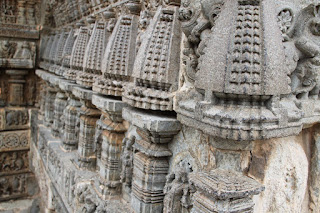The Keshava temple of Somnathpur is the last and the grandest of the Hoysala monuments. Somnathpur is about 140 kms from Bangalore, yes!! just 140 kms from Bangalore and you go centuries behind in history when all you can experience is grandeur and eternity.
The temple is hidden in a tiny agricultural village of Somnathpur on the banks of the river Cauvery, was founded by Hoysala's army commander Somath and he named the village after himself. It was he who petitioned the King to grant resources and permission to start the project. The Hoysalas had already completed 260 years of rule and their riches and pompus were already evident in their splendid temples at Belur and Halebid.
The temple at Somnathpur was built in 1268 AD, 740 years ago. The intricate carvings, the opulence, the engineering marvel are just breath-taking. It would make anyone from the present generation feel so waste and talentless, really I mean it!! We boast of so many things, but just visit these temples once, and you would feel so small!!
The temple is stellar in shape, just like the other Hoysala temples. This temple is better preserved than those at Belur and Halebid. It has three shrines of 3 Gods - Keshava, Janardhana and Venugopala. The temple is not used as a place of worship anymore due to the fact that all the idols have been damaged by invaders. First it was Malik Kafur and then Mohammed Tugluq's army. The temple was ransacked, looted and destroyed.
The entire breadth of the temple is adorned by plaques of Gods, Goddesses, Animals, celestial beauties, scenes of marriage processions, war, erotic poses..... These stone slabs are meticulously arranged; each slab interlocks with the other, no concrete or cement to hold them together :-) Marvelous is it not? But each and every portion of the temple is vandalized by the invaders, if its not the nose thats broken, then its the toe or the ear :-(
Out of the 3 idols in the 3 sanctum sanctorums, the idol of Janardhana and Venugopala is damaged and this second idol has been re-installed after being removed. But the idol of Keshava, the main God; is missing.
OK!! No more history, here are few pictures. Click to enlarge the picture to appreciate its intricacies :-)
One portion of the vimana, in which lies the sanctum sanctorum of the presiding deity. Also seen is the outlet from the main shrine.
The intricate carvings on a facade
A portion showing the stellar shape of the temple.
Seen from a different angle.
The celestial beauties and the lions. The Lion is the symbol of Hoysalas. Observe them carefully, each of their faces are damaged.
The swan, the varaha, carts being pulled for marriage procession and war.
Vishnu sitting on Sesha
The Brahma, triple headed. His face is vandalized. He holds among other things; a vase which contains amrit, the nectar of immortality
Indra riding on the elephant - Airavatha along with his consort Sachi. The elephant is depicted as if its running, its tail raised. Indra is holding the vajra - thunderbolt in his right hand
Vishnu and Lakshmi. Lakshmi rests her feet on a Lotus which is bent due to her weight but the elephant is supporting the Lotus
One of the many adorned ceilings, which depicts the various stages of the Lotus bud blooming. The outer two circles has design similar to horse shoe. The outermost ones depict some definite number(I forgot the number) of musicians playing different instruments.
Another one such ceiling showing a little more grown; about to bloom Lotus
The Venugopala. It may seem that the idol is intact and not vandalized. But observe the flute. Its broken :-(
One care write pages and pages describing the elegance and greatness of the architecture. I have so many other pictures to share along with its stories. I want to talk more about the artisans who created this masterpiece. But I would stop right here. This is just a glimpse of the vast wealth our ancestors have left for us.
To read about Belur and Halebid and see some pictures, check out my post - The Temples of Belur and Halebid
Click on Hoysala Architecture to know more about their building style.
To know more about the art and archeology of Somnathpur, click here - Somnathpur Temple








 illa
illa






.JPG)
